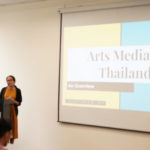Passings
2020 - Drawing & Print (Drawing & Print)
220 x 130 x 4 cm
Tarik Kiswanson
The artist’s Passings series are hand-sewn works composed of radiological scans of items of clothing loaned by the Tiraz Foundation in Jordan. These articles – Palestinian, Jordanian and other Arab costumes from the 19th and 20th centuries from the Widad Kamel Kawar dress collection – are mixed in with contemporary clothing sometimes borrowed from participants in Kiswanson’s performances. In this particular piece, a tracksuit is overlaid with an 18th century Jordanian Robe. These works have been described by Jones as an ‘archaeology of dress’ as a means of rehabilitating cultural heritage and tracing generational connections, ‘subtly nodding toward the ways in which Western culture so often seeks to erase difference.’ These works speak to practices of memory and preservation in the face of cultural and historical shifts.
Tarik Kiswanson is a Palestinian-Swedish artist, poet and writer based in Paris. His family exiled from Jerusalem to North Africa, and later to Jordan before finally arriving in Sweden in the beginning of the 1980s. Kiswanson studied in London and Paris and today splits his time between Europe and the Middle East. His identity is one defined by multiple cultures. His work stems from his own condition of being a first-generation immigrant shaped by the aftermath of the diaspora. It’s about living with the sensation of not belonging anywhere. Throughout his life, he has explored the question of identity, displacement, desire and the ‘in-between’ through writing and sculpture. The artist has described his work—which encompasses sculpture, writing, performance, sound, and video—as being “the border, the window between the iris and the world outside.” The window is less a demarcation between two opposed realms than a portal—a space between. This dynamic interstitial space nurtures his practice and animates his reflections on the human condition. His work evinces an engagement with the poetics of métissage : a means of writing and surviving between multiple conditions and contexts. Notions of rootlessness, regeneration, and renewal are recurring themes in Kiswanson’s oeuvre. His practice examines questions of displacement and interstitiality that specifically relate to the context of what is lost and what is gained, in the first generation of migration. He conceives works that articulate a fluid “politics of identity”, that encompasses the various collisions of culture that have shaped both his personal experience and artistic practice. His body of work can be understood as a cosmology of related conceptual families, each exploring variations on themes like refraction, multiplication, disintegration, hybridity, and polyphony through their own distinct language.
Colors:
Other related works, blended automatically
» see more

© » KADIST
Tarik Kiswanson
2018In late 2017, Kiswanson stared working with Vadim, an eleven-year-old Romanian-French boy who he met during castings for a performance...
Related works sharing similar palette
» see more

© » ARTS EQUATOR
Podcast 61: The Media Landscape in Thailand | ArtsEquator Thinking and Talking about Arts and Culture in Southeast Asia Articles Asian Arts Media Roundtable July 11, 2019 Duration: 20 min In our latest podcast, Thai theatre critic Amitha Amranand gives a comprehensive overview of the media landscape in Thailand, discussing the impact of the political and legal system on the arts and the paradoxical freedom that arts journalists have in the country...

© » LE MONDE
Au Musée juif de New York, requiem expressionniste pour les victimes du 7 octobre nav_close_menu Cet article vous est offert Pour lire gratuitement cet article réservé aux abonnés, connectez-vous Se connecter Vous n'êtes pas inscrit sur Le Monde ? Inscrivez-vous gratuitement Article réservé aux abonnés « Oct...
Other works by: » Tarik Kiswanson
» see more

© » KADIST
Tarik Kiswanson
2018In late 2017, Kiswanson stared working with Vadim, an eleven-year-old Romanian-French boy who he met during castings for a performance...
Related works found in the same semantic group
» see more

© » KADIST
Sahej Rahal
2015Within the narrative of Sahej Rahal’s The rocks we will find, beings perform absurd acts in derelict corners of the city, emerging into the everyday as if from the cracks of our civilization, transforming them into liminal sites of ritual, and challenging ways in which we experience time and space...

© » KADIST
Hoda Afshar
2022In the islands of the Strait of Hormuz off the southern coast of Iran, a distinctive local culture has emerged as the result of many centuries of cultural and economic exchange, the traces of which are seen not only in the material culture of these islands but also in the customs and beliefs of their inhabitants...

© » KADIST
Chto Delat
In this film is the story of two neighboring yet philosophically opposing nations: Russia and Norway...



